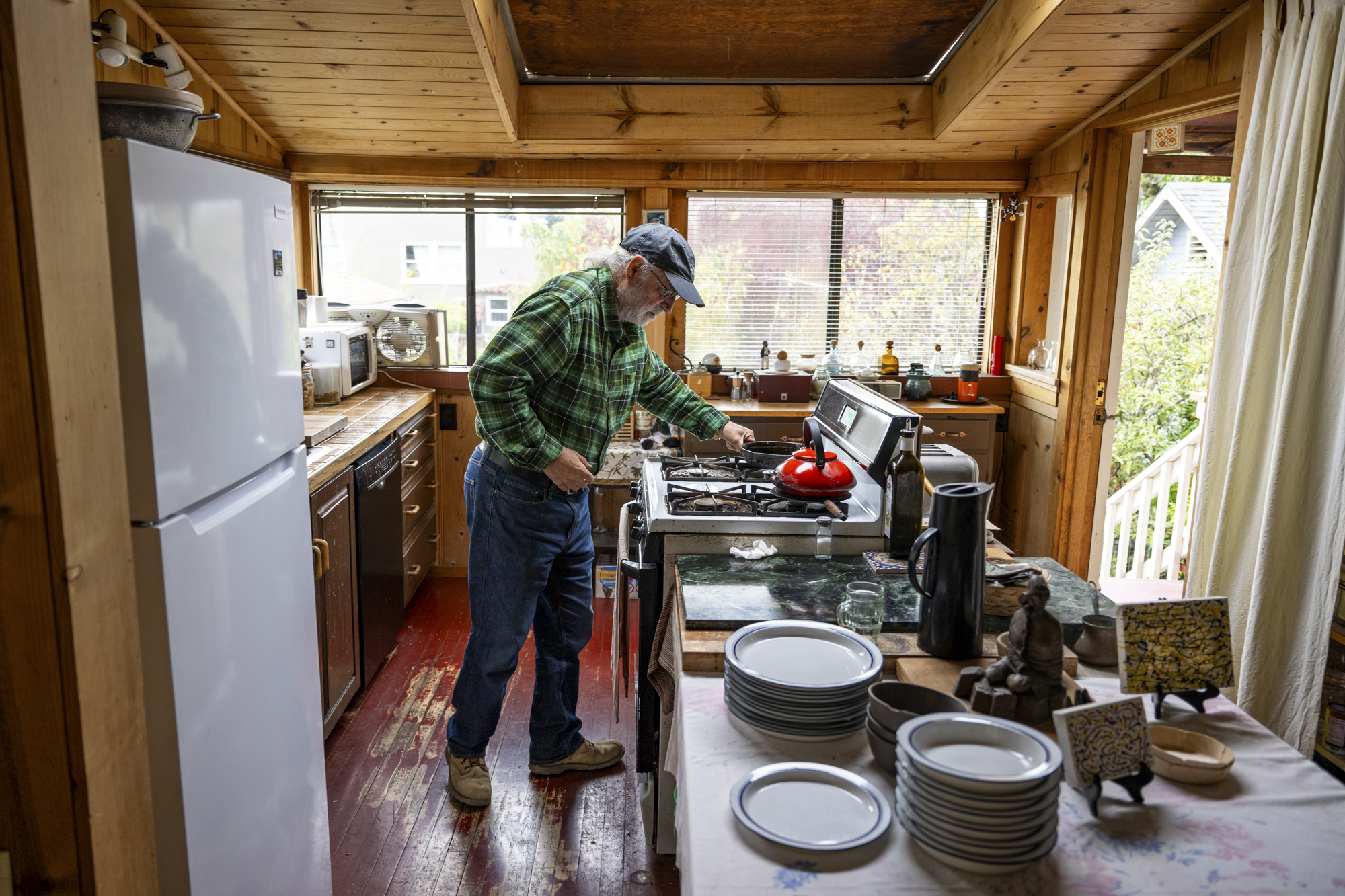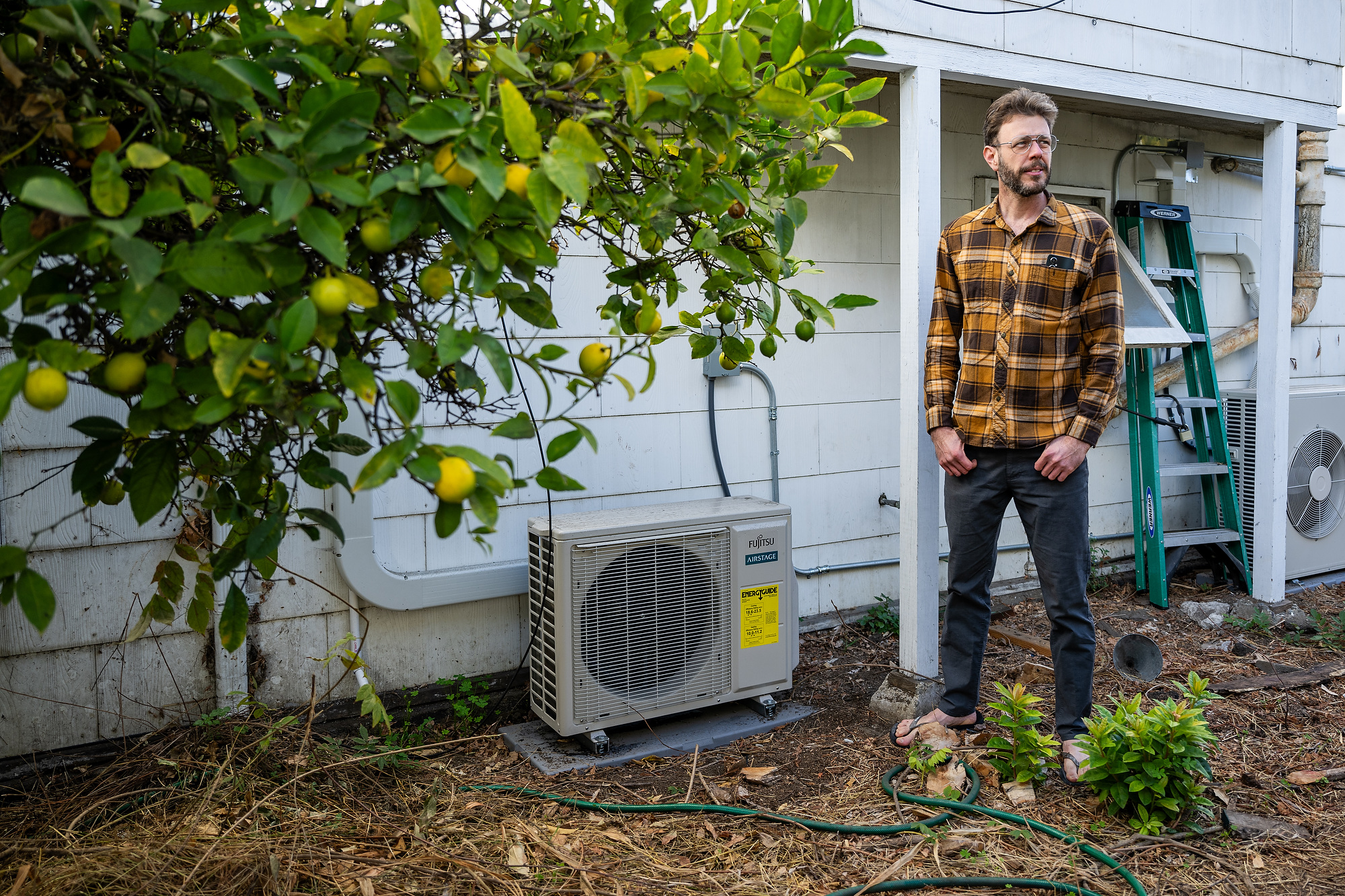In return, the researchers would get to test out a theory: would retrofitting buildings together, all at once, save money by buying in bulk? Would it save time for a contractor to walk from one job across the street to another? Would people even want to sign up?
The project would tackle a significant but overlooked issue: the planet-warming pollution that comes from buildings and the energy they use. In the U.S., that’s roughly one-third of all emissions.
A way to cut that pollution is to wean buildings off fossil fuels like natural gas and swap out gas appliances for electric ones. But doing this home by home and business by business is expensive and slow.
 Therese Peffer, a researcher from UC Berkeley’s California Institute for Energy and Environment CITRIS Climate initiative, helps neighbors plant trees on a block in Oakland on Jan. 26, 2025. The block is part of EcoBlock, a collaborative project bringing together academics, professionals, government agencies, utilities, private donors and residents. The initiative aims to help an entire city block reduce emissions through insulation upgrades, electric appliances and solar panels. (Beth LaBerge/KQED)
Therese Peffer, a researcher from UC Berkeley’s California Institute for Energy and Environment CITRIS Climate initiative, helps neighbors plant trees on a block in Oakland on Jan. 26, 2025. The block is part of EcoBlock, a collaborative project bringing together academics, professionals, government agencies, utilities, private donors and residents. The initiative aims to help an entire city block reduce emissions through insulation upgrades, electric appliances and solar panels. (Beth LaBerge/KQED)
So researchers at UC Berkeley’s California Institute for Energy and Environment set out to study if there was another way to slash pollution from buildings.
They felt there was already enough attention on how to construct new buildings for a warmer world. “New construction is easy, right? It’s sexy and it’s fun, but it’s not where the biggest problem is,” said Therese Peffer, who heads the project.
“If we’re going to try to really combat climate change, it is looking at the existing buildings in this country,” Peffer said — the millions of offices, warehouses, restaurants and homes we already have.
In 2019, Peffer and her colleagues at UC Berkeley got a $5 million grant from the state of California to test out a new, block-scale approach.
And Isaac Zones was ready to sign his block up as the guinea pig.
Getting neighbors on board
Isaac Zones and his wife, Vivian Santana Pacheco, had always cared about the environment, but their passion grew after they had their child, now in elementary school.
“We want this world to be a habitable one for him,” Santana Pacheco said. “Already, I feel like we’re behind, and that I’m not doing enough. This feels more tangible than showing up to a protest.”
 Issac Zones (left) and Vivian Santana-Pacheco (right) stand for a portrait in front of their electric vehicle in Oakland, California, on Aug. 11, 2023. The couple is a part of a group of neighbors in Oakland that are beginning to electrify their home appliances. (Juliana Yamada/KQED)
Issac Zones (left) and Vivian Santana-Pacheco (right) stand for a portrait in front of their electric vehicle in Oakland, California, on Aug. 11, 2023. The couple is a part of a group of neighbors in Oakland that are beginning to electrify their home appliances. (Juliana Yamada/KQED)
The pair went door to door, selling neighbors on the project, called “EcoBlock.” The task wasn’t unfamiliar: they’d gone door-knocking after moving to the block almost a decade ago. But that time it was to invite people out for a block party, which has since become an annual tradition.
Asking neighbors to come out for a beer is different than asking them to overhaul their largest asset, but Santana Pacheco and Zones had a lot of success.
Some residents were immediately game: they wanted air conditioning to deal with California’s increasing heat waves, and they valued how the project prioritized a low and middle-income neighborhood.
In the end, Santana Pacheco and Zones convinced 15 out of the 25 properties on the block to sign on.
The holdouts
So, who didn’t want to be part of EcoBlock?
Steve Johnson lives in a white Victorian that’s been in his family for almost 100 years. He’s a retired contractor and spent decades remodeling his home.
“I’m 70 years old. I just didn’t want to go through a lot of new construction all over again because I really don’t need it,” Johnson said.
 Steven Johnson stands in his kitchen in Oakland on Nov. 13, 2024. Johnson decided against participating in the EcoBlock project. (Beth LaBerge/KQED)
Steven Johnson stands in his kitchen in Oakland on Nov. 13, 2024. Johnson decided against participating in the EcoBlock project. (Beth LaBerge/KQED)
His energy bills are incredibly low already, and he thinks there are other ways to tackle planet-warming pollution; things like aviation fuel and shipping.
Plus, he isn’t ready to give up all fossil fuels just yet.
“I just can’t imagine not cooking on gas. And the whole EcoBlock wanted to take away the gas,” Johnson said.
That was a major goal of the project — weaning homes off natural gas, which is a powerful climate pollutant.
Other people who opted out of the project had done unpermitted work on their homes, and feared they’d get in trouble with the city. And some people felt distrustful of an outside institution leading the project.
EcoBlock faced other hurdles: a pandemic, supply chain issues and inflation.
As prices rose, the project shrank. Instead of an all-electric utopia, EcoBlock would mostly address the biggest sources of a home’s pollution: heating and cooling.
Workers, workers everywhere
Finally, in 2024, construction began.
Suddenly, there were workers everywhere, blowing insulation into walls, replacing HVAC systems and installing solar panels.
“We had this joke on the block: who’s getting the porta party in front of their house? That’s how we know who’s getting construction done,” Zones said.
 Salalai Vongsy, a contractor with Eco Performance Builders, works in Jesse Hassinger’s home in Oakland on Nov. 13, 2024, as part of the EcoBlock project. (Beth LaBerge/KQED)
Salalai Vongsy, a contractor with Eco Performance Builders, works in Jesse Hassinger’s home in Oakland on Nov. 13, 2024, as part of the EcoBlock project. (Beth LaBerge/KQED)
Now, five-and-a-half years after the block signed on, the work is almost done.
Neighbors are reveling in their new comforts: new heating and cooling, insulation, bathroom fans to improve air circulation, solar panels, new roofs to support them and more. The block has also had a facelift, with chunks of sidewalk concrete ripped up and trees and native plants put in.
Several more ambitious aspects of the project were scrapped along the way due to funding and feasibility limitations: a shared back-up battery, a community microgrid and a shared electric vehicle and charger.
But residents ultimately seem grateful for their upgrades and for having an outside entity coordinate all the details for them.
Did it work?
Now that the first EcoBlock is near completion: Did Therese Peffer and her colleagues’ theory work? Is upgrading a whole block faster and cheaper than going house by house?
Peffer’s takeaway: yes.
Here is why, and what they’ve learned.
 Nick Corlett stands next to a newly installed heat pump at his home in Oakland on Nov. 13, 2024, as part of the EcoBlock project. (Beth LaBerge/KQED)
Nick Corlett stands next to a newly installed heat pump at his home in Oakland on Nov. 13, 2024, as part of the EcoBlock project. (Beth LaBerge/KQED)
- Costs
- This pilot project was far more expensive than future ones. The EcoBlock pilot cost $8 million, funded by a state grant and a private donor. But that included the cost of all kinds of experts, and parts of the project that were designed but never used.
Peffer thinks the next attempt would cost just a third of that, and go much faster. “It takes that first time of kicking the tires and trying to break things to kind of lay that pathway for the next one,” she said.
- Buying in bulk saves money. Peffer estimates EcoBlock saved 10-20% on bulk purchases of equipment like appliances, wires and electric panels. They were also able to get more competitive bids from contractors, because multiple homes needed work.
- Return on investment for energy efficiency for low-income residents faces an unexpected hurdle. Many low-income residents have discounted energy rates and/or relatively low energy use, which means the timeline for the return on investment for energy efficiency improvements can be prohibitively long, according to the California Energy Commission.
- Proximity of buildings helps, but being on the same street might not be so important. The project contractor, Keith O’Hara, who heads Eco Performance Builders, said his crews saved time by being able to use the last few hours of a day to cross a street and start on a new project, or simply to help another crew carry a heavy appliance. But if a full block isn’t attempting to remove all gas appliances from their homes with the goal of removing a gas main beneath their road, they don’t necessarily need to be on the same block. “I just think it’s really hard to get all those people on the block to agree,” O’Hara said.



















